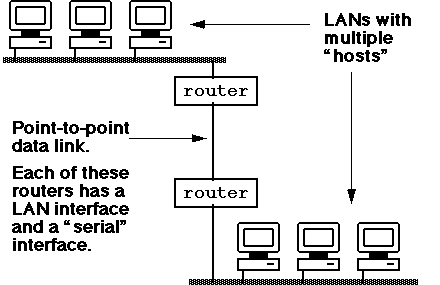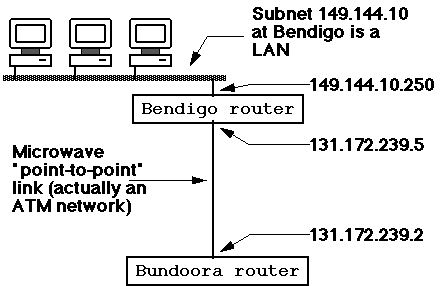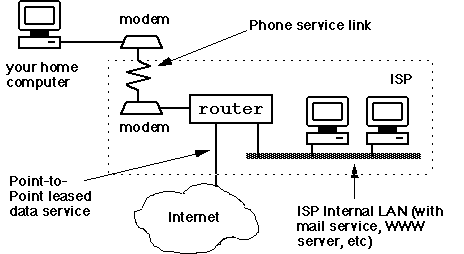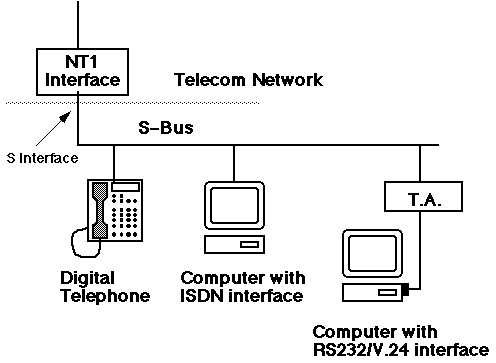Network Interconnects
We have already seen that the Internet consists of many networks
(or subnets) interconnected with routers.
Where a router is used to connect two geographically adjacent LANs
(see last lecture), it is simply equipped with two appropriate LAN
interfaces. Where the LANs to be connected are not near one
another, it is normal for a point-to-point link to be used,
thus:

IP Addressing in Point-to-Point Links
Each of the LANs in the previous diagram is a distinct network (or
subnet) for purposes of IP addressing.
Not so obvious is the fact that the point-to-point link is also a
network (or subnet), albeit one with only two hosts. For example,
between the Bundoora and Bendigo campuses of La Trobe University,
we have:

Point-to-Point Data Services
In almost every case, the point-to-point links used to connect two
geographically separated networks must be supplied by a licensed
telecommunications provider[1].
In Australia there are only two such providers, Telstra and Optus.
Telstra currently has the largest presence in the data communications marketplace.
Telstra has, at various times over the past decades, offered the
following (generally point-to-point) data services:
- PSTN
- or "Public Switched Telephone Network", a flash name
for
the ordinary old phone service.
- DATEL
- a "nailed up" or "leased line" variation on the PSTN
service. Officially deceased.
- DDS
- the original "Digital Data Service", now largely
obsoleted
by ISDN.
- AUSTPAC
- a "packet switched" data service providing "connect
on
demand" point-to-point links specifically for data transfer.
- ISDN
- The Big New Thing.
[1] Although there are some exemptions from this
rule in certain circumstances.
PSTN as a Data Service
In lecture 10, we saw how modems are
used to facilitate data
transfer over the phone system.
Modems are sometimes (although rarely) used to build
router-to-router links of the kind illustrated in slide 2 of this
lecture. More commonly, they are used to connect to dial-in
routers, a technology used by retail Internet Service Providers
to deliver Internet access to isolated computer systems.
The usual configuration of a dial-in router is such that hosts
which connect via modem appear to be directly connected to the
ISP's own LAN:

PSTN Charging
The charges for use of the PSTN are (still!) the same regardless
of whether it is used for voice or data transfer. The components
are (Telstra prices):
- Provision of phone service x 2 (installation approx $200 +
- Phone calls (local @ flat rate, $0.25, long distance @
temporal
STD rates). Note that there is no restriction on the
duration of
a local (flat rate) phone call, and that there is wide variation
in the definition of "local". Also, STD calls may be made using
Telstra or Optus, although comparison of relative rates is
difficult.
- Modems, two required. Currently approx $300 for 28.8 kbps
(V.34) and dropping rapidly.
A perturbation which may (drastically) affect Telstra's PSTN
pricing in the future is Optus' recently announced intention to
offer local call service using its new "Cable Television"
infrastructure.
Also, see later for discussion on "cable modem" technology.
Integrated Services Digital Network (ISDN)
ISDN provides an all-digital replacement for the PSTN. ISDN is now
widely available from Telstra, and most phone users now have the
option of choosing it. Optus has, apparently, no intention of
offering ISDN service.
Recall from lecture 11, the basic-rate
ISDN service provides:

An ISDN service is integrated in the sense that each B
channel
can be used to carry either a digitised voice (or video, FAX, etc)
call, or a 64 kbps data call. The D channel is normally used for
signalling (call setup, etc), but may also be used as a 16 kbps
data link under some circumstances. Although....
* In Australia, the ISDN interface is owned by the
telecommunications
provider, eg Telstra. This is not the case in some other
countries.
ISDN System Diagram
An ISDN service typically has the following components:

The S-Bus is a type of dedicated LAN. It uses 4 (or 6) wires, and
can extend between 100 and 600 metres from the NT1. A Terminal
Adapter (TA) is needed for DTEs without ISDN interface.
Telstra Basic-Rate ISDN Services
Telstra offers a range of ISDN services. Their current
strategic product is On Ramp 2, which is based on
the European ETSI standards. This largely replaces their
older Microlink service.�
Pricing for ISDN services is similar in principle
to an "ordinary phone service" (except more expensive), thus:
- Installation charge�
- Monthly rental�
- All call charges are time charged, with differential
rates for data and telephony calls.
Note, however, that nothing is ever simple in these deregulated
times, and that Telstra offers pricing in the context of a
range of plans, having various combinations of monthly
rental and allowances for free calls. Furthermore, it's worth
remembering that a basic-rate ISDN service actually provides
the equivalent of two phone services.�
Current pricing information is available on Telstra's Web pages:�
http://onramp.telstra.com.au/cost.htm
This lecture is also available in PostScript format.
The tutorial for this lecture is Tutorial #11.
[Previous Lecture]
[Lecture Index]
[Next Lecture]
Phil Scott





